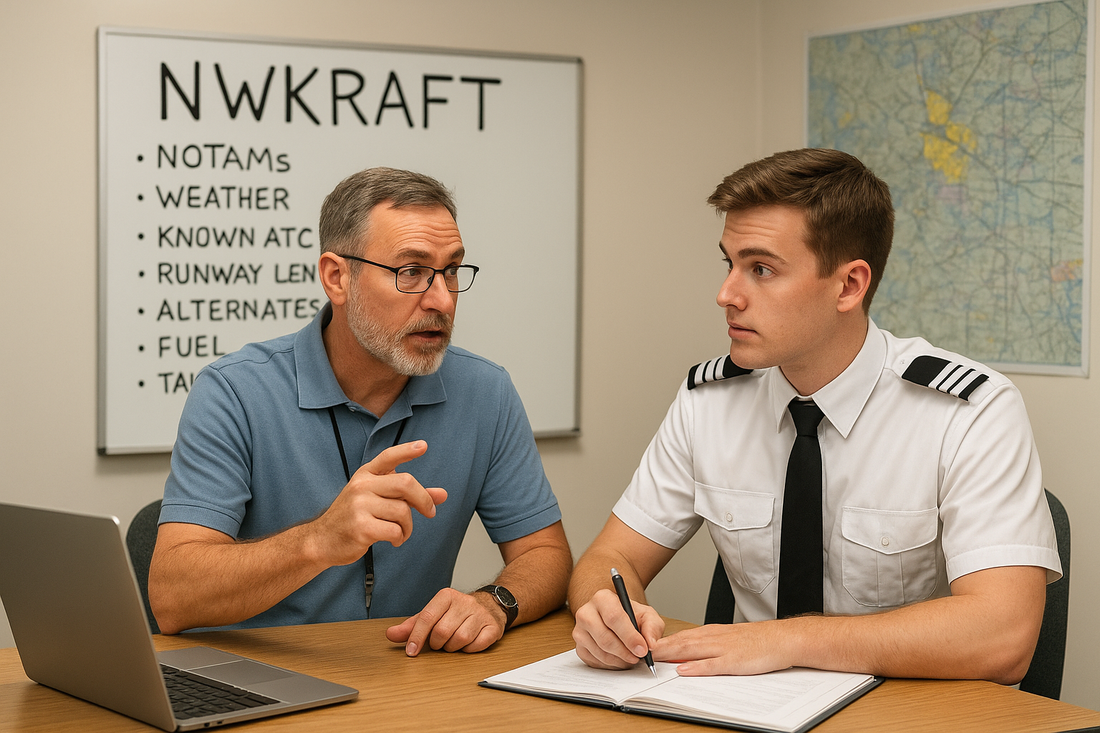
How And When Pilots Use NWKRAFT In Real-World Aviation Scenarios
By Walt Dillard, CFI
If you’re a student pilot, you’ve probably heard your instructor mention NWKRAFT more than once. It might sound like another alphabet soup acronym, but it’s actually one of the most useful tools in aviation.
In this post, we’ll cover:
-
What NWKRAFT means
-
Where it comes from in the FARs
-
How student pilots use it in training
-
How professional pilots apply it every day
-
Real-world examples you can relate to
By the end, you’ll see why NWKRAFT is more than just a checkride memory aid—it’s the foundation of safe and professional flying.
What Is NWKRAFT?
NWKRAFT is a mnemonic that helps pilots remember the required preflight actions outlined in 14 CFR §91.103, Preflight Action.
The regulation states:
“Each pilot in command shall, before beginning a flight, become familiar with all available information concerning that flight…”
That information includes:
-
Weather reports and forecasts
-
Fuel requirements
-
Alternatives if the flight can’t be completed
-
Known traffic delays
-
Runway lengths
-
Takeoff and landing distances
Instead of memorizing all that legal jargon, flight instructors teach NWKRAFT:
-
NOTAMs
-
WEATHER
-
Known ATC Delays
-
Runway Lengths
-
Alternates
-
Fuel Requirements
-
Takeoff/Landing Performance
NWKRAFT Breakdown With Real-World Examples
Let’s break down each item in NWKRAFT and look at how it applies to both student pilots and professional aviators.
N – NOTAMs (Notices to Air Missions)
NOTAMs are the “fine print” of aviation. They include changes to runways, taxiways, lighting systems, navaids, or airspace.
-
Student Pilot Example: You’re planning your first night cross-country. A NOTAM shows the runway lights are out of service at your destination. Without that check, you’d be arriving to a black hole.
-
Professional Pilot Example: Flying a Part 135 cargo run, you find the ILS is NOTAM’d out at your destination. Suddenly, your alternate requirement changes and so does your fuel planning.
W – Weather
Weather is obvious, but it’s more than just “VFR or IFR.”
-
Student Pilot Example: You check the TAF before a solo and see marginal VFR along your route. Even though the reg might not prohibit it, your personal minimums say, “Not today.”
-
Professional Pilot Example: You’re scheduled for Aspen. The forecast shows snow showers and mountain obscuration. That changes not only your go/no-go decision but also your alternate and fuel requirements.
K – Known ATC Delays
ATC issues like ground stops, reroutes, and holds can affect your flight before you leave the ground.
-
Student Pilot Example: Not common, but if you’re flying into a Class B airport for training, checking ATC advisories helps avoid surprises.
-
Professional Pilot Example: Scheduled to depart for JFK during rush hour? Expect flow programs and 45-minute delays. That means more fuel and schedule adjustments.
R – Runway Lengths
Not all runways are created equal.
-
Student Pilot Example: You plan to land at a 2,800-foot strip in a Cessna 172. The POH says you need about 1,200 feet over a 50-foot obstacle. Technically legal, but do you feel comfortable with that margin?
-
Professional Pilot Example: Flying a King Air into a high-elevation strip on a hot day. On paper the runway length works, but density altitude eats away at your performance.
A – Alternates
Always have a backup.
-
Student Pilot Example: On a solo, you plan a nearby Class D airport as your alternate if weather moves in unexpectedly.
-
Professional Pilot Example: Flying IFR into Chicago Midway with ½ mile visibility forecast. Legally, you must file O’Hare or another nearby airport as an alternate and plan fuel accordingly.
F – Fuel Requirements
Legal minimums aren’t always safe minimums.
-
Student Pilot Example: FAR 91.151 requires 30 minutes reserve VFR day. If your flight will take 1.5 hours and you only have 2.0 usable fuel, it’s legal but far too tight.
-
Professional Pilot Example: Under Part 135, you must include taxi fuel, enroute, holding, alternate, and 45 minutes reserve. Suddenly that “optional” fuel stop becomes mandatory.
T – Takeoff and Landing Performance
Performance numbers matter in every airplane, from a 152 to a Gulfstream.
-
Student Pilot Example: On a hot afternoon, you calculate your 172 needs 1,700 feet for takeoff. The runway is 2,000 feet. Waiting until evening when it cools down is the safer call.
-
Professional Pilot Example: You’re in a corporate jet with a full passenger load. High elevation and hot temps mean you need to offload weight to safely depart.
Why Pilots Use NWKRAFT
Here’s the truth: most inflight problems start on the ground. They happen because a pilot skipped a detail during preflight planning. NWKRAFT keeps you from skipping the details.
-
Student Pilots use it as a checklist and learning tool. At first, you’ll probably write it down before every cross-country. Later, it becomes second nature.
-
Professional Pilots may not say “NWKRAFT” out loud, but you’ll hear it in their decision-making. “Runway’s too short,” “Weather’s below alternate mins,” “Fuel margin is tight”—that’s NWKRAFT in action.
NWKRAFT as a Teaching Tool
As a CFI, I tell my students: NWKRAFT isn’t just for passing a checkride—it’s about thinking like a PIC.
When you ask yourself these questions before every flight, you’re building professional habits:
-
Did I check the NOTAMs?
-
Is this weather safe for me, not just legal?
-
Do I know my alternate?
-
Am I comfortable with this runway?
-
Do I have the fuel to handle surprises?
-
Does my performance data fit the conditions?
That’s the difference between simply flying an airplane and commanding one.
Final Thoughts
NWKRAFT is the bridge between legal requirements and real-world pilot judgment.
-
For students, it’s a simple acronym that ensures you don’t forget critical preflight items.
-
For seasoned pilots, it’s a mindset—applied automatically in every decision.
Whether you’re flying your first solo or transporting passengers at altitude, NWKRAFT keeps you ahead of the airplane and prepared for the unexpected.
Remember: shortcuts on the ground turn into emergencies in the air. Use NWKRAFT every time, and you’ll be flying with confidence, safety, and professionalism from day one.
By Walt Dillard, CFI
If you’re a student pilot looking for helpful study tools and flight gear, NorthstarVFR.com is a trusted resource designed with your training in mind. We offer carefully curated pilot supplies and study materials, including our popular Pre-Tabbed FAR/AIM, Oral Exam Guides, kneeboards, logbooks, and more. Everything is selected to help you stay organized, pass your checkrides, and fly with confidence. Check it out and set yourself up for success in the cockpit.
